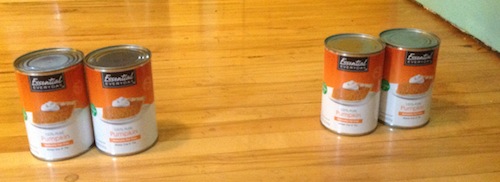Fall baking in our house requires canned pumpkin. We were out so I asked for Tabitha’s help at the grocery store, where the pumpkin in on the bottom shelf.
Me: Put four of those bright orange cans of pumpkin in our cart, please.
Tabitha (6 years old): I don’t know if I can carry four.
Me: Do two, then two more.
T: [With two cans of pumpkin in her hands] I know, because two plus two is four.
Me: Right. You could do three and one, I suppose.
T: OK. Give me one back.
She takes it, picks up two more from the shelf and brings the three cans over to me.
T: I did two and three.
Me: So we have five cans?
T: No! You gave me one back, remember?
Me: So two plus three minus one is four?
T: Yeah.
So what do we learn?
Decomposing numbers is fun.
We tend to think of 2+2 as something to do, and that the answer is 4. But in this case 4 is the thing to do, and 2+2 is one of several possible answers. When we think about different ways to make 4, we are decomposing 4.
Tabitha can keep track of the moves in our complicated decomposition at the end (You gave me one back, remember?) but she does not have practice with the math notation that captures all of these moves (Two plus three minus one is four). That is one of my roles in the conversation.
Starting the conversation
Tabitha gave me the ideal beginning to this conversation—she pointed out that there were too many cans for her to carry. It shouldn’t be difficult to put your own child in such a situation. The grocery store sells lots of things that children can carry a few of, but not a lot of: apples, oranges, cans of soup, etc. Picking up toys at the end of a play session at home or school, or books at the library—all of these are opportunities for you to name the number involved, then suggest a way to decompose it.

